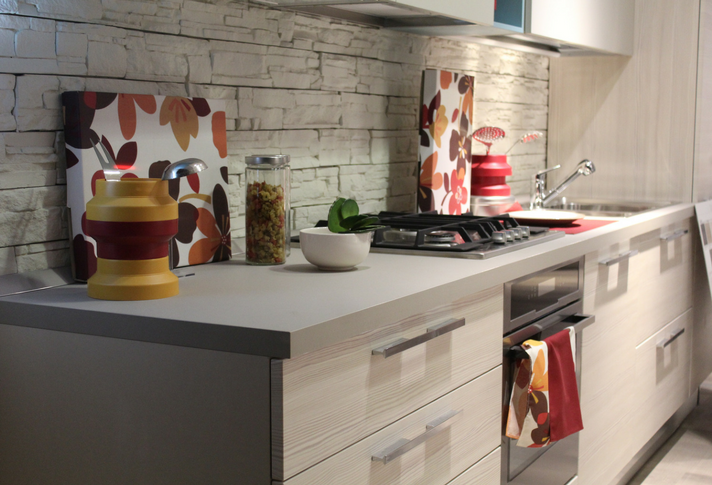By Vicki Matranga, Design Programs Coordinator
In the late 1800s, home economists and social reformers focused their attention on the functionality of the American kitchen and improving the efficiency of domestic labor. Kitchen furnishings were spare, with an 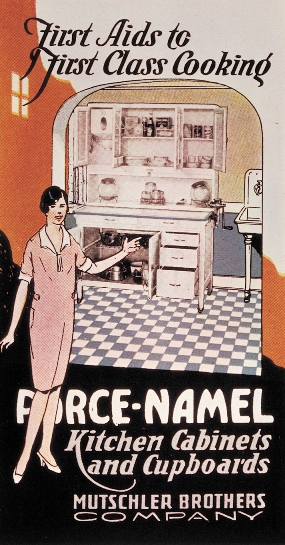 assortment of simple work tables, cupboards and wall shelves. By 1900, the pace of change sped up. Industrialization provided mass-produced lumber and supplies for home construction. Furniture makers and home builders reconsidered the floor plan for kitchens in houses for moderate income families. Manufacturers of food preparation and cooking equipment sold countless technically ingenious, manually powered devices in stores and through national mail order catalogs. Food production and merchandising grew; homemakers could buy prepared and packaged foods in standardized units, making it easier to bake pies or fix dinner. And in the booming post-World War I economy that moved people from farms to cities, all of these developments came together in the free-standing, multi-purpose kitchen work station that came to be known as the “Hoosier” cabinet.
assortment of simple work tables, cupboards and wall shelves. By 1900, the pace of change sped up. Industrialization provided mass-produced lumber and supplies for home construction. Furniture makers and home builders reconsidered the floor plan for kitchens in houses for moderate income families. Manufacturers of food preparation and cooking equipment sold countless technically ingenious, manually powered devices in stores and through national mail order catalogs. Food production and merchandising grew; homemakers could buy prepared and packaged foods in standardized units, making it easier to bake pies or fix dinner. And in the booming post-World War I economy that moved people from farms to cities, all of these developments came together in the free-standing, multi-purpose kitchen work station that came to be known as the “Hoosier” cabinet.
By 1910 many cabinet manufacturers were based in Indiana, the most notable being the Hoosier Manufacturing Company, in New Castle. Advertising promised the cabinets would banish kitchen drudgery and bring beauty, comfort and convenience to daily life. The cabinet reduced labor by saving steps in the kitchen and providing efficient storage and work areas. Outfitted with porcelain-enameled work surfaces, pull-out cutting boards, integrated bins for flour and sugar complete with sifters, spice rack, cookbook holder, sliding shelves for pots and pans, drawers for hand tools and dish towels, and sometimes built-in electrical outlets and light fixtures or a swing-out stool, such cabinets changed the lives of middle-class American women in the 1920s. Modern housekeeping was defined by steps and time saved in kitchen work.
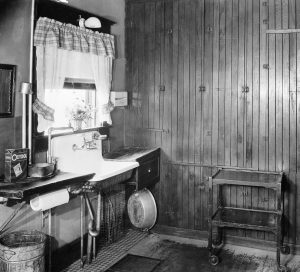 In the 1930s, dream kitchens began to feature continuous work surfaces and built-in cabinets, replacing the stand-alone Hoosier cabinet. While during the Great Depression many American kitchens in cities or rural areas remained plain, homemakers could fantasize about gleaming, streamlined kitchens of the future. Appliance makers such as General Electric and Westinghouse promoted products such as electric refrigerators, stoves and miracles like dishwashers (!), in their pavilions at the great expositions of the decade—in Chicago at the Century of Progress and the New York World’s Fair—and in national advertising.
In the 1930s, dream kitchens began to feature continuous work surfaces and built-in cabinets, replacing the stand-alone Hoosier cabinet. While during the Great Depression many American kitchens in cities or rural areas remained plain, homemakers could fantasize about gleaming, streamlined kitchens of the future. Appliance makers such as General Electric and Westinghouse promoted products such as electric refrigerators, stoves and miracles like dishwashers (!), in their pavilions at the great expositions of the decade—in Chicago at the Century of Progress and the New York World’s Fair—and in national advertising.
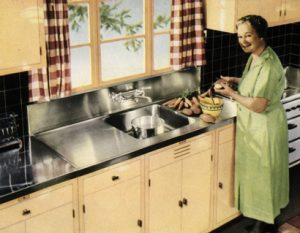 Today, stainless steel sinks and countertops appear in high-design, modern kitchens. Yet in 1934, Monel Metal, an alloy of nickel and copper trademarked by the International Nickel Company, brought the kitchen “up-to-date”. Monel Metal, used in the construction of buildings, industrial equipment and aircraft, food service facilities and hospitals, now entered the single-family home. Described as “the right material for durable kitchen sinks”, Monel’s broad product line included single and double sinks, integrated drain boards, countertops that spanned built-in cabinets, an 8” backsplash and wall-mounted faucets. Product catalogs stated “Your kitchen should be one of the most attractive rooms in your house…so much time is spent there!…Modern equipment helps to make the planned kitchen convenient and efficient, at the same time creating an ensemble which is both…beautiful and satisfying.”
Today, stainless steel sinks and countertops appear in high-design, modern kitchens. Yet in 1934, Monel Metal, an alloy of nickel and copper trademarked by the International Nickel Company, brought the kitchen “up-to-date”. Monel Metal, used in the construction of buildings, industrial equipment and aircraft, food service facilities and hospitals, now entered the single-family home. Described as “the right material for durable kitchen sinks”, Monel’s broad product line included single and double sinks, integrated drain boards, countertops that spanned built-in cabinets, an 8” backsplash and wall-mounted faucets. Product catalogs stated “Your kitchen should be one of the most attractive rooms in your house…so much time is spent there!…Modern equipment helps to make the planned kitchen convenient and efficient, at the same time creating an ensemble which is both…beautiful and satisfying.”
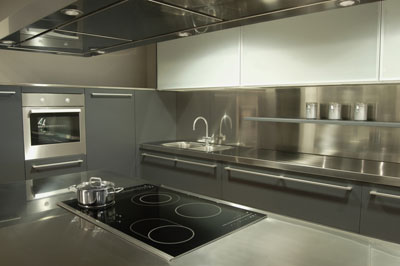
Inspiring, right? Makes you want to remodel your kitchen… Looking at kitchens of the past can get you thinking of how your housewares products fit and work in your kitchen. Today we live in those “kitchens of tomorrow”, yet we still crave beauty and time-saving convenience.
